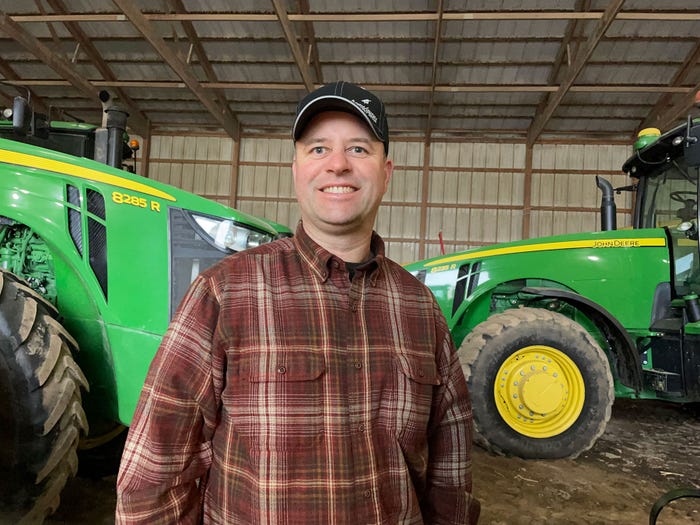
As farmers anxiously await a final thaw and warmup, many can’t help but wonder what is ahead. What were once familiar cycles in farming are becoming less typical. Weather, markets, input availability and prices all contribute to production challenges.
Michigan Farmer caught up with a couple Michigan growers — Jason Dunning, who is farming about an hour northwest of Grand Rapids, and Mark Senk, who is growing crops about a half-hour west of Flint — to get their input on the 2024 growing season and their plans.
Dunning’s plan
Dunning, a fifth-generation grower from Fremont, Mich., is running Dunning Farms LLC with his brother and father. They raise corn, soybeans, wheat, alfalfa and a few pumpkins on 1,200 acres. About half the acreage is for cash crops, while the remainder goes to feed about 700 dairy heifers annually.
Making the most of the wheat crop has been a passion for Dunning, and this year, the farm is replacing a single nitrogen application with two. An early-season liquid application with sulfur will go on in mid-to-late March, and the second pass before flag leaf. Fungicide applications will also be applied at flag leaf and at flowering.
“It’s better stewardship of the ground by helping to prevent leaching, and with the cost of fertilizer, it’s important to utilize that nitrogen at the right time,” says Dunning, who is a Michigan Wheat Program board member.
They’re also splitting nitrogen applications with corn, coming back at pre-tassel with a system called NutraBoss, which is a dual fertilizer placement tool (Y-drop) to evenly distribute nutrients near the root zone. Recently, they’ve gone to strip-tilling corn, which Dunning says saves time, fuel and allows roots to get down deeper.
Early in 2023, Dunning wondered if he would have a corn crop because of drought conditions. “But in the end, the crop finished spectacular, producing a record crop for the farm,” he adds.
Looking ahead, cattle prices, in general, look promising. “Dairy heifer replacements demands have been strong as well as the beef market, which has been holding prices up,” he says.
He’s resisting the temptation to switch from corn to soybeans given market conditions. “I need to keep the rotation to keep balance between cash crops and feed for the cattle,” Dunning says, while noting farmland is very competitive no matter where you farm.
Optimistic or pessimistic?
As a district manager for Dairyland Seed, Dunning has been gauging the sentiment among growers.
“Most dealers, customers and others I’ve talked with at meetings are optimistic, although enthusiasm is waning a bit with prices being down,” he says. “Seed input costs for 2024 will be slightly higher from 2023, but not significantly.”
Profitability, particularly in corn, is drawing concern, especially with the threat of tar spot.
“Tar spot is the wild card,” Dunning says. “Last year, we thought for sure we had the perfect scenario for it to show up, but it was past the point of making an impact. If we had a normal spring, I think it would have shown up when we really didn’t want it. Many parts of Michigan did not have rain for 45 days early in the season, which pushed tar spot mostly past black layer corn.”
Dunning remains hopeful higher markets will return eventually, especially with what’s happening globally and with a growing world population.
“We might not get $5 corn, but maybe $4.50, that’s where we could be a little more comfortable than currently,” he says. “Budgeting and knowing your cost of production will be very important for 2024.”
The cattle business looks to be most positive for 2024, he thinks, but that could be throttled by a tightening economy. “People might struggle to afford beef, and therefore look for alternatives,” Dunning says. “But, even so, I’m pretty optimistic with the cattle market in general.”

FIRST GENERATION: Mark Senk, who is the Michigan Soybean Committee president, worked off the farm for 16 years before becoming a first-generation, full-time farmer. (Photo courtesy of Mark Senk)
Senk’s 2024 plan
Senk, who farms 3,000 acres of corn, soybean and wheat in Owosso, Mich., with his father and three teenage sons, is putting the brakes on upgrading machinery after the past few years of investments.
“We’re coming off some decent years where we were able to purchase a combine and a new sprayer,” he says. “We were hit hard with tar spot in 2021. We were spraying everything except tasseled-out corn. We wanted the ability to spray timely fungicides on corn without having to wait for a custom applicator with an airplane.”
Senk, who is the Michigan Soybean Committee president, worked off the farm for 16 years before becoming a first-generation, full-time farmer. He’s had some success with non-GMO soybeans and plans to continue.
This past year produced near-record, if not record, yields. Soybeans were above average, while wheat brought average yields.
His biggest curveball this upcoming season will be making adjustments to deal with a heavier load during the spring and fall, as only about 25% of his intended acres of wheat were planted — steady fall rains and unfit conditions were the deterrents. “I’ll probably split the extra acreage between corn and soybeans,” Senk says.
He doesn’t like the disruption in rotation, as most of his wheat is sold out of the field, which means a little less than normal income in the July-to-August time frame.
In addition, the farm normally trades straw for manure with a local dairy, which means not as much manure will be applied as normal.
Typically, farm crops are stored until after the first of the year, but that will have to change, too, as they won’t have enough on-farm storage. “We’ll have to move some of the fall crop that we normally don’t at harvesttime,” Senk explains.
It creates a ripple effect. “You have to work with what you have,” he says. “That means more acres to plant this spring and more to harvest in the fall, but I don’t see that as too much of an issue for my operation — we can cover it with my dad and boys.”
Looking ahead
It’s in Senk’s nature to always be optimistic. “There’s always a positive out there, but things don’t look as profitable as they have in the past,” he says.
When things get challenging, Senk likes to reflect on past success. “2023 was a very good year for marketing of the 2022 crop, with success in storing the crop and marketing it with high prices.”
About the Author(s)
You May Also Like






